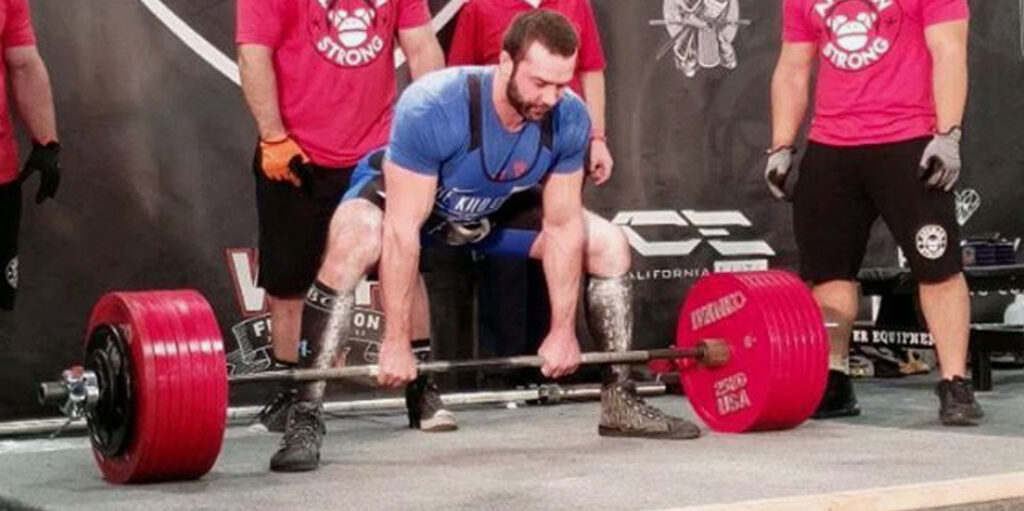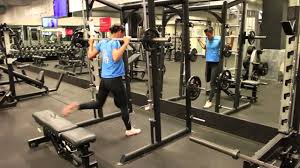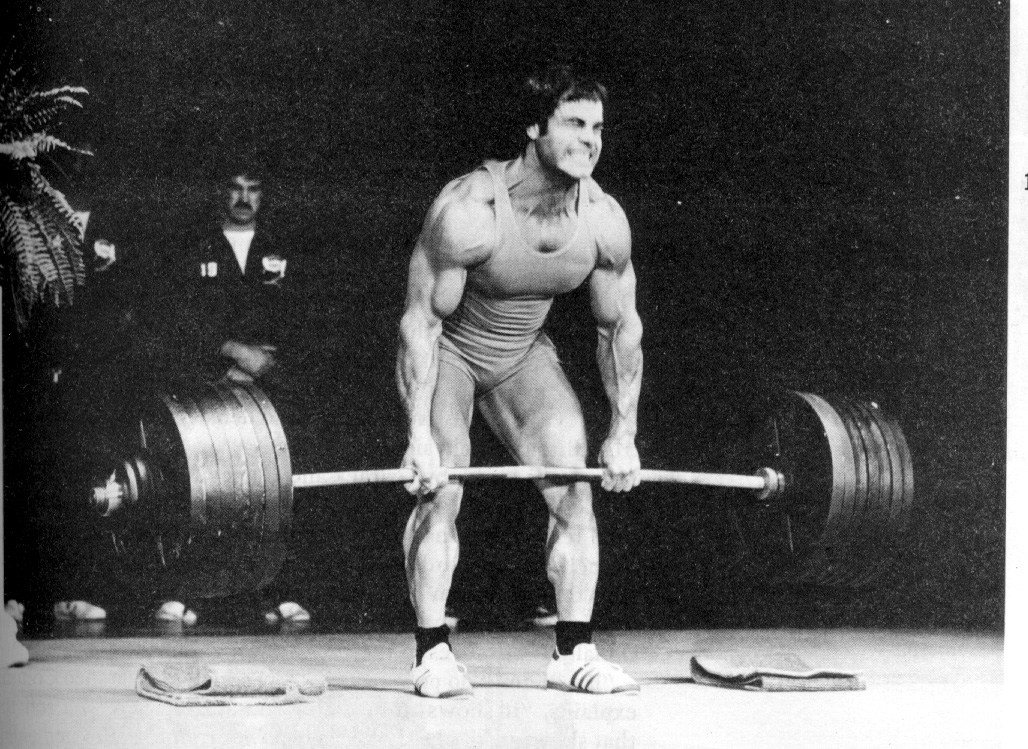The deadlift is the king of all lifts. Picking up weights and putting them back down is fundamental for muscular development.
The deadlift is sometimes picked as the king of lifts for all-round muscle building and conveyance of strength.
Of course, there are some mechanically-gifted deadlifters who are lanky ectomorphs. But, even then, they can throw around some serious weight.
For example, 950lb deadlifter Cailer Woolam can barbell row in the mid-500s for reps and bench close to 500lb even though he struggles to pack on mass.
And speaking of Mr. Woolam A.K.A Dr. Deadlift, our first exercise is one I pilfered from a training video he did at Super Training gym in Sacramento, California.
The Best Deadlift Accessory Movements

1) Barbell Row With “Body English”
First off, do not attempt this exercise unless you have flexible hammies and decent hip mobility. You need to be a relatively advanced lifter to pull this one off safely — but it’s incredibly effective.
This movement is incredible for breaking past plateaus and adding mass and strength to your entire upper back and posterior chain.
It’s basically a cheating barbell row.
At the bottom of the movement, you essentially have a paused deadlift then explode up into a supramaximal barbell row.
A strong upper back is absolutely irreplaceable for heavy deadlifting as it will enable you to rip the weight off the floor more confidently as well as prevent the rest of your back from rounding.
This very exercise helped me deadlift 6 plates for the very first time — something I was 10-20lb away from doing for almost TWO YEARS.
The deadlift is a very psychological movement and it is easy to erect barriers.
When I finally pulled 6 plates, it looked like a speed rep.
Anyway, this variation of the barbell row will also carry over to your squat and bench press in helping to maintain tightness in your upper back.
Almost every elite powerlifter — regardless of weight class — will stress the importance of building a strong upper back.
2) Box Squat
While this may sound awfully cliché at first glance, I assure you it isn’t.
Now, there are two different box squat variations you could add to your arsenal depending on your preferred stance — conventional or sumo.
2a) Conventional Deadlift Stance Low-Bar Box Squat
That’s one heck of a mouthful.
Walk up to the bar, and place it on your rear delts as if you are about to perform a low-bar squat.
Walk the bar out and stand with your feet at your conventional deadlift stance width, then proceed to squat to a box set at a height equal to your deadlift starting position.
This movement will mimic your conventional deadlift position from the floor.
DO NOT ATTEMPT TO GO TO PARALLEL; DO NOT GO “HEAVY” ON THIS EXERCISE
As it is not a natural movement unlike the conventional squat itself, I would not recommend going to parallel as the vast majority of lifters simply do not possess the mobility to do so and would round their lower back in the process.
Try lighter loads — around 40-50% of your deadlift 1RM — for sets of higher reps, e.g.: 3×10-12.
2b) Wide(r) Stance Box Front Squat
If you pull sumo, try a wide(r) stance box front squat.
I’m not saying you should outright mimic your sumo pulling stance in this lift, but adopt the same width as you would with your squat.
This movement is simply a front box squat, with a little pause at the bottom.
With this exercise, you can afford to go heavy and work in rep ranges that best serve to complement your main lift.
You aren’t putting yourself in too much of an unnatural position with this movement as with 2a.
What I love about this movement, in particular, is the awesome strength that your upper back and core gains from blasting off the box.
Moreover, this movement also significantly carries over to the squat.
3) Power (Cheating) Barbell Shrugs
You need immensely strong traps to pull huge weights. Strong traps will complement your deadlift throughout the movement.
If you’re weak off the floor, build your traps. If you’re weak in the middle, build your traps. If you’re weak at lockout, build your traps.
I’ve always been naturally weak off the bottom off the deadlift and focusing on my upper back strength, rather than doing tons of pause and deficit deadlifts, really helped me take my pull to new heights as it helped enable me to rip the weight off the floor more confidently.
This movement would usually follow my barbell rows on a specific upper back and posterior chain day, that I used to fit into my program when I did powerlifting.
I do, however, have a couple of rules — even though I encourage a light bit of cheating with this movement:
First, if you can’t deadlift it, you can’t shrug it properly.
You often see egomaniac gym bros attempting to shrug weights over 100lbs more than their top deadlift — and it often resembles a walking pigeon’s head movement.
So, instead of pulling it off a rack, deadlift up the shrugging weight before your set.
This might mean pulling 80-90% of your deadlift max, but it ensures you’re not ego-lifting.
Second, even though you’re “cheating” by doing power shrugs, make sure that you’re actually shrugging the weight.
I use to aim for 2-3 sets of 10. If I felt particularly energetic, I sometimes threw in an AMRAP set at the end (as many reps as possible). And I assure you, shrugging close to 600lb for 10 reps is not fun the next day.
I am a huge fan of supramaximal lifting, but you’ve gotta make sure you’re resting adequately.
Going balls to the wall and doing supramaximal lifts week in week out will eventually stunt your progress because it’s too damn taxing on your nervous system, muscles, and connective tissue.
Make sure you cycle your supramaximal training and use proper programming to recover fully.
4) Weakness Romanian Deadlift (for super high rep ranges)
Another cliché movement, but with a twist.
If you’re simply looking to lift as much raw weight as possible, then throw this damn exercise into your program.
Some gym bros looking to bust through deadlifting plateaus might do the Romanian Deadlift with beautiful form — a 3-second downtempo and a controlled concentric.
While this is fine and dandy if you’re a bodybuilder, you’re missing out on a great opportunity to get strong as hell in the deadlift.
When I used to powerlift, it was my lifting philosophy to mercilessly attack my weaknesses.
And, as I’ve previously mentioned, I was weak off the floor, so I would do Romanian Deadlifts from just above the ground to my upper shin.
And I would do them for high rep ranges. Once I did this movement for 50 reps in a working set.
The strength I gained in my hammies and upper back was marvellous.
But first, before attempting this variation, you need to ascertain which third of the deadlift you’re weak on.
To do that, you need to film yourself attempting a submaximal load at around 80-90% of your 1RM to see where you begin decelerating on the movement to identify your weakness.
Most people struggle with the middle and bottom portion of the movement — which makes this Romanian Deadlift ideal to address those weaknesses.
If your weakness lies in the middle of the lift, you can start this exercise from where you begin to stall until just before lockout, taking the Romanian deadlift, say, from mid-shin to over the knees and back.
If you’re one of the unlucky ones that struggles at lockout, you need to 1) strengthen your traps (see exercise 3) 2) bring your hips through 3) correct your lockout positioning.
Try using a cable pull-through, kettlebell swings with resistance band, or knee-high block pulls to correct lockout difficulties.

The following is taken from: https://herculeanstrength.com/increase-your-deadlift-and-squat-with-this-one-trick-the-herc-squat/
You’ll be thanking me for the enormous gains you’ll make to your deadlift, squat, and glute development; but you’ll hate me when you use the can in the days after training.
All you have to do is set safety pins on the Smith Machine, have a bench parallel to the Smith Machine, get under the bar, raise your inactive leg onto the bench — as if you were actually performing a Bulgarian Split Squat.
(I’m not kidding or trolling — the Smith Machine can actually bring some value to the table!)
My twist here is the whopping overloading of the bar that you can get away with. The bar path is restricted by the Smith Machine itself, reducing the need to expend energy on stability.
The safety pins will stop the bar from descending too low to reduce the risk of injury.
Combined, you can really go to town in throwing the weight around.
Moreover, new accessory movements drilled into your program are easy to PR on.
When I first started these, I could do 3.5 plates a side. After a few months, this increased to nearly 5 plates a side.
My max squat at the time was in the mid-500s, and, within a year, I added over 60lb to my squat — mostly because of this exercise.
Now, let’s take a step back: 3.5 plates — or 160kg on the bar — per leg translates to the equivalent of a 320kg squat. I have never attempted to walk out more than 7 plates a side in my life — far less than what I began dealing with.
Then sooner, rather than later, I almost went up to 5 plates a side on my right leg — the equivalent load of a 420kg squat. And don’t forget, thus far, I’m a lifelong natural lifter.
I will never squat anything close to that.
Even if I gained 150lb, blasted tren, deca, anadrol, dbol, and any other compound I could get my hands on for a decade, I’d never be able to squat that.
I would usually do this exercise as my 1st or 2nd accessory movement on my squatting day, depending on how I’m feeling.
Working sets should never exceed six reps as they are very taxing on the joints and inner thighs at heavier weights.
Doing the equivalent of a half squat ONTO SAFETY PINS is more than enough range of motion for this particular movement, with supramaximal loads.
(You can use knee wraps and a belt if it makes you feel more comfortable.)
Your glutes, inner thighs, and quads — in that order — will be exceptionally sore for the days after training, so be warned.
Do not program this exercise on a basis more frequent than one month on, one month off as it can be taxing on the body.
Don’t hesitate to email us at [email protected] for personalized coaching and a client questionnaire if you’d like DEDICATED tailor-made personal training on strength training, building muscle, losing fat, developing athleticism, and more — all to your liking, lifestyle, habits, and taste!
Otherwise, don’t forget to claim your FREE eBook detailing how to lose 20lb of fat while building muscle in 12 weeks! You can claim it here.
Alternatively, you can pick up a FREE eBook on fundamental strength principles offering an introductory workout program.











